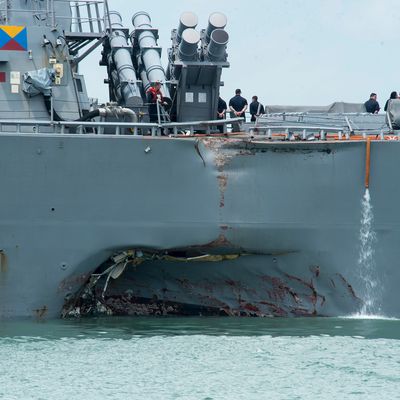
The U.S. Navy on Thursday ended the search-and-rescue mission for the nine sailors still missing after Monday’s collision between the U.S.S. John S. McCain and an oil tanker. Its efforts will now be focused on recovery, an acknowledgement that the sailors are not expected to be found alive.
Before calling off the rescue portion of the mission, the U.S. and multinational partners spent 80 hours searching a 2,100-square-mile area near Singapore, the Navy’s Seventh Fleet said in a statement. The remains of one missing sailor were found on the ship. He was identified as Electronics Technician 3rd Class Kenneth Aaron Smith, 22, from New Jersey. On Thursday, the Navy named the other nine sailors still missing:
- Electronics Technician 1st Class Charles Nathan Findley, 31, from Kansas City, Missouri
- Interior Communications Electrician 1st Class Abraham Lopez, 39, from Texas
- Electronics Technician 2nd Class Kevin Sayer Bushell, 26, from Maryland
- Electronics Technician 2nd Class Jacob Daniel Drake, 21, from Ohio
- Information Systems Technician 2nd Class Timothy Thomas Eckels Jr., 23, from Maryland
- Information Systems Technician 2nd Class Corey George Ingram, 28, from New York
- Electronics Technician 3rd Class Dustin Louis Doyon, 26, from Connecticut
- Electronics Technician 3rd Class John Henry Hoagland III, 20, from Texas
- Interior Communications Electrician 3rd Class Logan Stephen Palmer, 23, from Illinois
The McCain is now at Singapore’s Changi Naval Base, where its flooded compartments are being searched for further signs of the missing sailors. The search of the sea does not appear to have yielded any relevant remains. The Royal Malaysian Navy did find a body while searching the ocean Tuesday, but it was not one of the missing sailors.
Thursday’s announcement comes as ships in the Seventh Fleet have been ordered to observe an operational stand-down, allowing commanders to assess safety procedures. Each ship in the fleet has been directed to dedicate a day to reviewing safety standards, updating protocols, and running emergency drills.
“History has shown that continuous operations over time causes basic skills to atrophy and in some cases gives commands a false sense of their overall readiness,” Admiral Scott Swift said in a statement.
“There can be no bystanders,” he added. “Bystanders become weak links and need extra attention and leadership. During this pause, focus on fundamentals — both individual and team.”





























